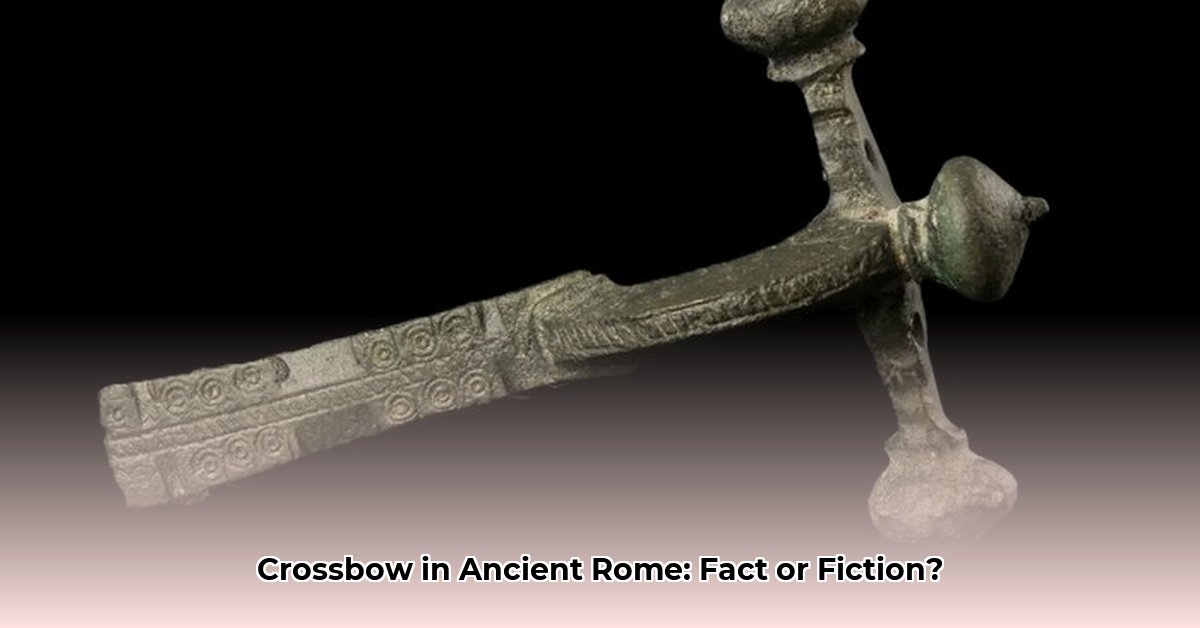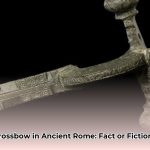The arcuballista, a weapon shrouded in historical ambiguity, represents one of the most intriguing technological puzzles of the Roman Empire. The Roman military dressed for success; see examples of their military clothing. Was this device, distinct from the mighty siege engines, a widespread battlefield innovation or an obscure experiment? This article delves into the scarce textual mentions and rare archaeological traces to dissect the true nature and potential impact of the Roman crossbow, separating established facts from enduring scholarly assumptions. By meticulously examining the evidence, we aim to clarify its place within the vast Roman military arsenal and illuminate its tactical utility, or perhaps its limitations, in ancient combat.
The Elusive Arcuballista: Discerning Textual and Archaeological Traces
Our foremost textual source for the arcuballista is Vegetius, a Roman military theorist writing in the late 4th century AD. In his influential work, Epitoma Rei Militaris (often translated as “Summary of Military Matters”), Vegetius makes crucial distinctions. In Book II.15, while describing legionary formations, he refers to soldiers who shoot bolts with manuballistae and arcuballistae. The term manuballista (Latin for “hand projector,” derived from the Greek cheiroballistra) is generally understood as a hand-held, torsion-powered bolt-shooter, akin to a miniature ballista. Crucially, Vegetius explicitly differentiates the arcuballista from this torsion-powered category.
Later, in Book IV.22, discussing siege and naval warfare, Vegetius continues to distinguish “scorpions” (now manuballistae) from other hand-held projectile weapons like fustibali (staff-slings), slings, and notably, arcuballistae. This consistent differentiation is pivotal, strongly suggesting the arcuballista was a weapon utilizing a flexion bow—a true crossbow—rather than a scaled-down catapult. Regrettably, Vegetius offers no detailed description, stating his contemporary readers would be “familiar with their form and function.” This tantalizing omission has fueled centuries of debate, leaving modern historians to piece together its appearance and operation from scarce clues. The notable silence from other Roman authors on this specific weapon further deepens its mysterious historical profile.
Archaeological discoveries, while scarce, offer tangible, albeit fragmented, glimpses. Ancient carvings found at Gallo-Roman sites in France, particularly the stone reliefs from Solignac and Saint Marcel, depict figures wielding crossbow-like weapons. These images, unlike the distinct crescent-shaped stomach rests of the Greek gastraphetes, suggest a different design. Furthermore, fragments resembling revolving nuts—a critical component of early crossbows for releasing the bowstring—have been unearthed in Roman Britain, dated to the 5th or 6th century AD. These finds underscore the conceptual presence and potential use of such mechanisms within late Roman contexts. However, compared to the overwhelming abundance of other Roman military artifacts, such as swords, javelins, and shield fragments, definitive arcuballista components remain exceedingly rare. This rarity poses a fundamental question: was the arcuballista widely adopted and mass-produced, or was it a specialized, perhaps experimental, weapon limited in its deployment? A significant absence in the archaeological record is that of dedicated spanning devices, such as cranks or windlasses, typically required for powerful crossbows. This suggests that the arcuballistae depicted or inferred might have been spanned by hand, a method that would inherently limit their draw weight, and thus their power and range.
Reconstructing the Roman Crossbow: Challenges and Theories
The precise physical characteristics and operational mechanics of the arcuballista remain largely theoretical, derived primarily from interpreting the limited visual evidence. Based on the Gallo-Roman reliefs, scholars like Erwin Baatz have proposed plausible reconstructions. These suggest a design incorporating a revolving-nut release mechanism, a technological innovation that remarkably foreshadows the standard trigger systems of later medieval crossbows. The Solignac relief, for instance, clearly depicts a revolving-nut release for the bowstring, along with a groove for the bolt, proving its ancestral link to medieval designs.
Baatz’s illustrative sketches envision an arcuballarius (crossbowman) spanning the weapon by placing a foot on the bow, on either side of the stock, and drawing the bowstring by hand. This manual spanning method implies a draw weight low enough to be pulled by human strength, a stark contrast to the powerful, mechanically spanned medieval crossbows. Proposed dimensions, based on scaling from the figures in the Saint Marcel relief, include a stock length of approximately 600-700mm and a bow length of around 1300mm (tip to tip). An interesting detail gleaned from these reconstructions is the probability that the arcuballista fired arrows, rather than the shorter, heavier bolts typically associated with medieval crossbows, given the hypothesized longer draw length and the placement of the nut towards the end of the stock. It is also unlikely that the prod (bow) was made of steel, as in later medieval crossbows; self-bows or composite bows were more probable.
Diverse theories circulate regarding the arcuballista‘s intended role within the Roman military. Some scholars propose it functioned as a specialized weapon for siege warfare, capable of precise, armor-piercing shots from a fortified position or during an assault. Its mechanical advantage, even with a limited draw weight, could offer greater accuracy and penetration than a traditional bow at certain ranges. Others speculate it armed mobile soldiers, such as light infantry or scouts, providing them with enhanced ranged firepower for skirmishing or reconnaissance, a role potentially supported by mentions of balistari (possibly crossbowmen or artillery operators) as scout units by figures like Julian the Apostate.
Conversely, a compelling counter-argument posits that the arcuballista may not have gained widespread popularity. Potential drawbacks include a slower reload time compared to traditional bows, which Roman sagittarii (archers) could fire at a rapid rate. Additionally, the Romans already possessed other effective projectile weapons, from javelins (pilum) to sophisticated torsion artillery (ballistae and onagri), which might have fulfilled similar tactical requirements more efficiently or reliably at scale. The persistent scarcity of archaeological finds, combined with the lack of detailed contemporary descriptions, further supports the notion that the arcuballista was not a standard-issue weapon for legionaries but perhaps a specialized, regional, or experimental device. Its presence highlights the Roman military’s continuous innovation and adaptability, even if certain designs did not achieve widespread adoption.
Unanswered Questions and Future Research Trajectories
The arcuballista remains a profound historical puzzle, underscoring critical areas for future investigation. The precise draw weight of the weapon, which directly impacts its range and penetrative power, is still an enigma. Similarly, the materials used for its bow—whether a simple self-bow, a composite construction, or an early form of steel—are undefined. Why have more definitive components like nuts, triggers, or bow fragments not been unearthed at Roman military sites, especially given the Roman Empire’s vastness and archaeological richness? This persistent lack of physical evidence challenges definitive conclusions and invites further inquiry.
To truly unravel the mystery of the Roman crossbow, a concerted, interdisciplinary approach is essential. This involves:
Military Historians: A crucial step is to re-evaluate existing textual evidence, such as Vegetius’s writings and other fragmentary mentions, conducting meticulous linguistic and comparative analyses with other Roman weapon systems and military doctrines. Long-term goals include spearheading experimental archaeology projects, where historically plausible arcuballistae are constructed based on available evidence and rigorously tested. This would involve assessing their performance against contemporary projectile weapons like composite bows and torsion artillery (e.g., the manuballista), specifically evaluating range, accuracy, and armor penetration. Such systematic investigation promises to shed light on its potential impact on Roman battle tactics and the broader evolution of projectile technology.
Archaeological Researchers: Prioritizing and expanding excavations in Roman military regions, particularly in Gaul (where reliefs have been found) and Britain (where nut components have been identified), is vital in the hopes of uncovering more definitive arcuballistae components or equivalent pieces. Short-term efforts should focus on re-examining existing artifact collections, analyzing weapon find locations for contextual clues, and applying advanced imaging techniques to existing reliefs for finer detail. Long-term, conducting scientific analyses on any discovered materials (e.g., wood, bone, metal) and modeling ballistic performance based on potential designs will refine our understanding of their capabilities.
Reenactors/Living History Groups: Developing historically plausible arcuballistae reconstructions based on scholarly interpretations and available evidence, and incorporating them into Roman military demonstrations, can offer invaluable practical insights into their handling, spanning, and firing. Collaborating closely with academics and museum curators can lead to interactive exhibits that accurately showcase advancements in Roman military weaponry, allowing the public to compare and contrast arcuballista technology with other contemporary military tools and appreciate the engineering challenges involved.
Wargame Designers and Digital Modelers: Integrating the arcuballista as a specialized, rather than widespread, unit in historically-themed Roman wargames can help model its stats based on the best available archaeological and textual evidence. This can involve developing sophisticated scenarios that explore the theoretical effects of wider arcuballista adoption on Roman tactics, considering logistical constraints, troop training requirements, and potential countermeasures. Such digital simulations can serve as a powerful tool for visual hypothesis testing, furthering public engagement and scholarly debate.
The arcuballista endures as a captivating testament to Roman ingenuity and their relentless pursuit of military advantage. While definitive proof of its widespread adoption as a standard battlefield weapon remains elusive, existing evidence strongly suggests its presence as a specialized, perhaps experimental, weapon. Further rigorous research, combining meticulous historical analysis, targeted archaeological investigation, and innovative experimental archaeology, is paramount to fully unraveling the mystery of the Roman crossbow. Was it a secret weapon, or simply an experiment that never quite achieved widespread deployment? The investigation continues, reminding us that even well-documented societies hold secrets yet to be revealed.










